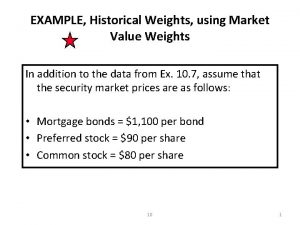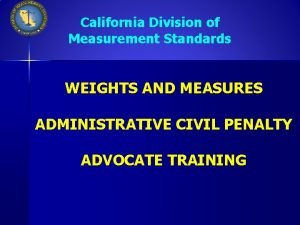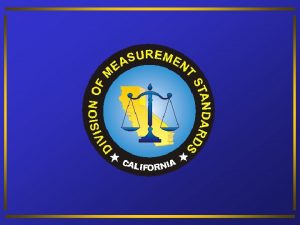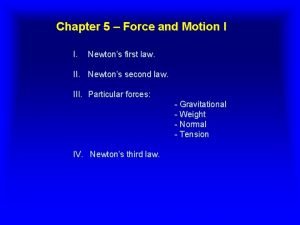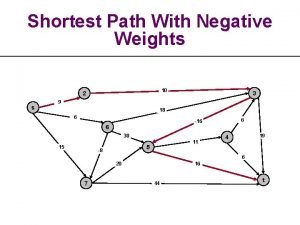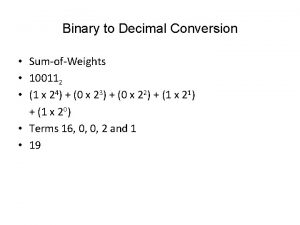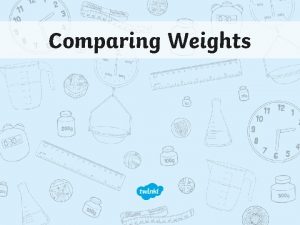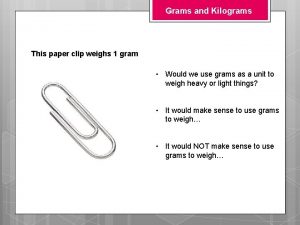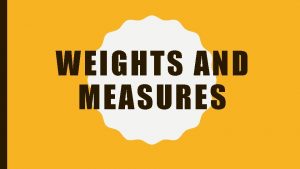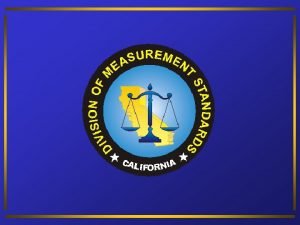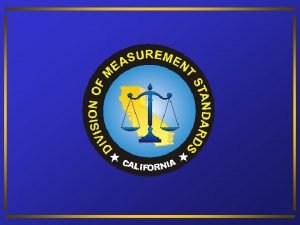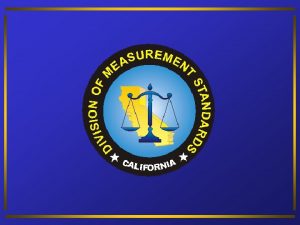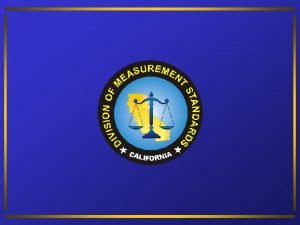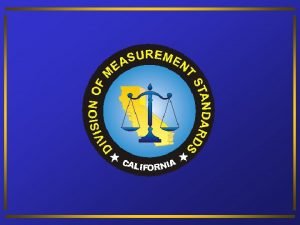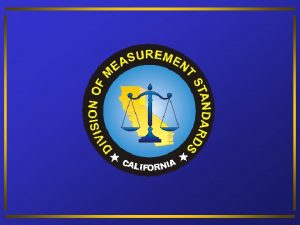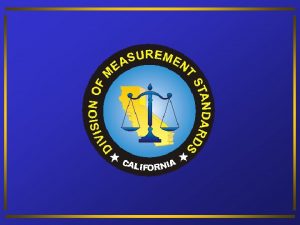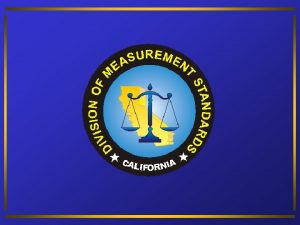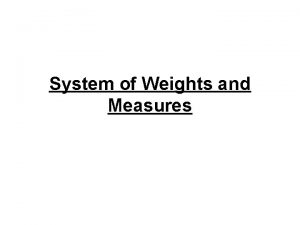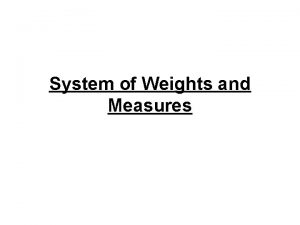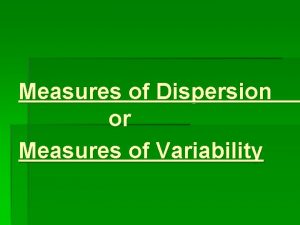TRAINING FOR THE WEIGHTS AND MEASURES OFFICIAL COURSE



























































- Slides: 59


TRAINING FOR THE WEIGHTS AND MEASURES OFFICIAL COURSE CURRICULUM MODULE 1 Introduction MODULE 2 Laws & Regulations MODULE 3 Enforcement Procedures MODULE 4 Legal Action MODULE 5 Legal Metrology MODULE 6 Field Standards & Test Equipment MODULE 7 Basic Weighing / Measuring Principles

TRAINING FOR THE WEIGHTS AND MEASURES OFFICIAL COURSE CURRICULUM MODULE 8 Device Type Evaluation MODULE 9 Weighing Devices MODULE 10 Measuring Devices MODULE 11 Weighmaster Enforcement MODULE 12 Petroleum Products MODULE 13 Quantity Control MODULE 14 Service Agencies and Agents

TRAINING FOR THE WEIGHTS AND MEASURES OFFICIAL Module Nine “Weighing Devices” Ninth in a series of 14

General Overview This module will: Familiarize you with weighing devices Introduce various terms and definitions Discuss enforcement tools used by the field inspector Prepare you for “hands on” field training

Module Objectives Understand the difference between commercial and non-commercial use Understand the importance of type approval Be able to describe the basic construction and use various weighing devices Be familiar with the reference tools used in inspection and testing weighing devices

General Considerations In every commercial transaction involving the weighing of a commodity over a scale, accurate weights and proper weighing practices protect both the buyer and seller v Buyer and seller have a right to equity v The seller has a right to fair value v The buyer can compare values

Commercial or Non-Commercial Determination of Weight For the purchase or sale, barter or trade of any commodity or thing Of any commodity or thing upon which determination of a charge for service is based Includes devices such as parcel scales, shipping scales, and scales used in the payment of agricultural workers Normally occurs in the presence of the customer If not, a weighmaster certificate is required

Commercial or Non-Commercial Weighing performed within a business as part of the manufacturing process Pre-packaging scales used for filling packages to a pre-determined weight The determination of charges for the transmission of letters or parcels of less than 150 pounds, except when that determination is made in the presence of the customer charged for the service

Role of Weights and Measures Responsibility of the Weights and Measures Official Inspect, test and seal commercial scales that are correct Ensure that weighing practices protect the interests of all parties Remove scales from commercial use that are found to be incorrect

Authority Business and Professions Code of California § 12027 & 12107 The Secretary of Food and Agriculture may: v Make laws and regulations v Establish tolerances, specifications and other technical requirements for commercial weighing and measuring NIST Handbook 44 Adopted by reference, with exceptions

Reference Tools Business and Professions Code DMS – Field Reference Manual Device Enforcement Program Manual

Business and Professions Code: Division 5, Chapters 1 -17, pertaining to Weights and Measures These are the laws adopted by the State Legislature requiring you, or prohibiting you from doing something More information about Laws and Regulations is discussed in Training Module 2

Field Reference Manual References the California Code of Regulations (Title 4, Division 9) NIST Handbook 44 adopted by reference, with exceptions CCR 4000 sections same as HB 44 4000 CCR 4001 sections are not adopted from HB 44 4001 CCR 4002 requirements are different than, or in 4002 addition to requirements in HB 44

California Code of Regulations The specifications, tolerances, and other technical requirements established by the California Code of Regulations apply to: v Commercial weighing devices v Any accessory attached to or used in connection with a commercial weighing device that affects the accuracy of the device v Weighing devices used for law enforcement purposes

CCR Paragraph Designations Organized into different codes by type of device or subject G. This prefix indicates the requirement is part of the general code A. Application. Type of device or subject the section applies or does not apply to S. Specifications. Relate to design of equipment. Mostly applies to equipment manufacturers N. Notes. Applies to the official testing of the device

CCR Paragraph Designations T. Tolerance. Performance requirements that fix the limits of allowable error from true value T. N. Tolerance for scales marked with an accuracy class (Jan. 1, 1986) UR. User Requirement. Directed to the owner of operator of the device. Applies to the selection, installation, use, and maintenance of the device D. Definitions of Terms. In appendix D, provides a definition of terms having special meaning

Device Enforcement Program Manual Includes basic considerations associated with the enforcement of device code regulations: Theory of Tolerances Inspection vs. Testing Methods of Sealing Checklist to determine jurisdiction for weighing and measuring devices interfaced to computer systems Directory of DMS Notices, DMS Policy Letters and EPO References

Device Enforcement Program Manual It also incorporates the ‘Examination Procedures Outline for Commercial Weighing and Measuring Devices’ Guide for determining if devices are correct and suitable for commercial service Outline for a minimum examination preceding official action References sections of B&P and CCR

Examination Procedures Outline Checklists for: Newly Installed Weighing Devices Indicators – Automatic & Non-Automatic Shift Test & Substitution/Strain Load Tests Electromagnetic Interference Test Weight Truck Calibration Guidelines Measuring Devices Weighing Devices Customer Operated Devices

Words of Caution to Weights and Measures Officials § Program manuals and Examination Procedures Outline are only guidelines to assist you with your job only § They are not the law § They cannot be referenced as violations when issuing a Notice of Violation, or writing a citation, criminal or civil case § You must reference the correct Business and Professions Code or California Code of Regulations

Scale Components All scales have the same basic components: Load-Receiving Element Weighing Element Indicating Element

Load-Receiving Elements The load rests upon a: Platform or deck of wood, steel or concrete Platter or pan, conveyor belt, hopper, tank or monorail Supported by a suspension system that transmits the load to the indicating element

Weighing Elements Transmit the force of the load from the load receiving element to the weight indicating element Lever Systems - Mechanical scale Load-cell Systems - Electronic scale Electro-mechanical - Both mechanical and electronic

Weighing Elements Transmit the force of the load from the load receiving element to the weight indicating element Lever Systems - Mechanical Scale Load-cell Systems - Electronic Scale Electro-mechanical/Levertronic - Both mechanical and electronic

Indicating Elements Weighbeams Dials Electronic Indicator

Weighbeams Non-Automatic Indicators Scale operator must perform action to obtain reading Typical Weighbeam Assembly

Weighbeams with a sliding poise can balance a considerable range of load Read when the weighbeam tip rests in the center of the trig loop or when tip oscillates equidistant from the center

Weighbeams Counterpoise Weights Capable of balancing large loads depending upon scale ratio Requires computation to obtain total weight Counterpoise weight with scale ratio (1 lb. weight will balance a 100 lb. load on the scale deck)

Weighbeams with balance indicators Over and Under Indicator Graduated Balance Indicator

Dial Indicators Analog May indicate throughout the whole range of the scale Chart capacity only or … test at the quarter positions for linearity

Dial Indicators May be equipped with a: Tare Bar - For balancing off the weight of an empty container Capacity Bar - To supplement the capacity of the reading face

Electronic Indicators Applications Electro-mechanical Scales Mechanical scales converted to electronic indicator Electronic dials Levertronic Scales Both mechanical and electronic indicators Tested as two separate scales Full electronic Scales

Electronic Indicators Common features: Tare mechanism (must be indicated) On-Off switch Push-button tare Keyboard tare Dial tare mechanism Zero-setting mechanisms Semi-auto and auto-zero Center of zero indication Gross/net weight Unit selection (must be indicated) ZERO TEST TARE Push-button print CLEAR lb kg PRINT Push-Button Controls On An Electronic Indicating Scale

Electronic Indicators Computing Scales Scales Indicate money values for an amount of product weighed at predetermined unit prices Point of Sale Systems Consists of a scale and indicator interfaced to an electronic cash register (ECR), many times with a scanner. This system may utilize price look-up (PLU) codes which may have tares automatically entered for a product

Accuracy Classes Weighing devices are divided into accuracy classes according to the number of scale divisions (n) and the value of the scale division (d). There are five classes of scale categories: I Precision laboratory weighing. II Laboratory weighing precious metals & gem weighing grain test scales. III All commercial weighing not otherwise specified, grain test scales, retail precious metals and semi-precious gem weighing, animal scales, postal scales used to determine laundry charges, and vehicle on-board weighing systems. III L Vehicle, axle-load, livestock, railway track scales, crane, hopper (Other than grain hopper) scales, and vehicle on-board weighing systems. IIII Wheel-load weighers and portable axle load weighers used for highway weight enforcement (Generally the California Highway Patrol).

Accuracy Classes v The majority of commercial scales fall into class III or III L v Scales manufactured after Jan. 1, 1986 are required to be marked with these class designations v Older scales without these designations are referred to as ‘unmarked’ scales. These scales are placed into classes based on their use v Application of scale tolerance depends upon the class of scale being tested

Tolerances are accuracy criteria used by weights and measures officials Table 6. Maintenance Tolerances (All values in this table are in scale divisions) Scale tolerance values are based on scale divisions or the number of ‘d’ Tolerance in Scale Divisions 1 2 Class 3 5 Test Load I 0 – 50 000 II 0 – 5 000 5 001 - 20 000 III 0 – 500 501 ‑ 2 000 IIII 0 – 50 51 - 200 III L 0 – 500 501 ‑ 1 000 50 001 ‑ 200 000 200 001 + 2 001 ‑ 4 000 201 ‑ 400 4 001 + 401 + (Add 1 d for each additional 500 d or fraction thereof)

Theory of Tolerances v Errorless value or performance is unattainable v Tolerances are established to fix the range of inaccuracy acceptable for commercial use v “Tolerance values are so fixed that the permissible errors are sufficiently small that there is no serious injury to either the buyer or the seller of commodities, yet not so small as to make manufacturing or maintenance costs of equipment disproportionately high. ”

Tolerances CCR - Scales Sets the tolerance limit for inaccuracy allowed for a particular device v Acceptance Tolerance is generally one-half of maintenance tolerance and is applied to scales that are new or undergoing type approval v Maintenance Tolerance permits an additional amount of deterioration before the scale is placed ‘out of service’. Applies to scales already in commercial use

Pre-Test Determinations Type Approval: Check compliance with certificate of approval or conformance Include software verification where applicable Suitability: Consider appropriate use weighing produce with a postal weight classifier Minimum load – not less than 20 d Marking Requirements: Required information aids in determining suitability and approval

Marking Requirements Common to all devices Manufacturer name, initials or trademark Model designation Nonrepetitive serial number

Marking Requirements Additional information that may be required on scale systems and components depending upon manufacture date: NTEP Certificate of Conformance Number Maximum Scale Divisions Accuracy Class Concentrated Load Capacity Nominal Capacity Minimum Dead Load Scale Division emin and vmin Maximum Capacity Section Capacity

Device Inspection The primary purpose of a scale examination is to ensure that the device is accurate and correct A device can be accurate but not correct

Device Inspection n To be accurate a scale must meet, within applicable accurate tolerances, specific performance requirements determined during testing n To be correct a scale must be accurate and meet all applicable specification requirements (design, type approval, selection, installation, use, and maintenance)

Inspection Procedures include verification of ‘Method of Operation’ v Used according to manufacturer’s instructions v No facilitation of fraud v Compliance with user requirements

Testing v Testing is done to determine compliance with performance requirements v Testing will vary according to the device being tested v Testing procedures are contained in the EPO found in the Device Enforcement Program Manual v It is recommended that you train with qualified county or state officials before proceeding with field testing v There are numerous safety issues to consider before testing a device

Sealing When a device is found to be ‘correct’, it must be sealed before commercial use In addition to the familiar approval seal, most devices have provisions for security sealing mechanisms used by service agents to make adjustments and calibrations There are primarily three ways to secure the calibration and parameter mechanisms Although none will prevent access, they provide evidence of tampering

Physical Sealing The traditional method using a lead and wire seal Another method is with tamper-resistant or pressure sensitive seals. These will tear or transfer markings if an attempt is made to remove the seal If either of these seals are not intact, the integrity of device is compromised It is illegal to use an unsealed device in commerce Security Sealing

Electronic Sealing Many electronic indicators are capable of calibration and parameter changes through the keyboard These are sealed with either a physical seal to a calibration switch or with an electronic ‘audit trail’ that is password secured The ‘audit trail’ has two counters that monitor access to the configuration parameters and the calibration parameters These counters increment each time a parameter is accessed

Audit Trails When devices are capable of parameter changes through remote access, more sophisticated tracking may be necessary An event logger may be required depending upon remote configuration capabilities or category of device Categories of Device and Methods of Sealing are contained in Table S. 1. 11. of the CCR 2. 20 Scales

Audit Trail Access The device type approval or certificate of conformance will indicate how the device is to be sealed When a device is sealed with audit trails, those numbers must be recorded on the certificate of inspection. Recording those numbers is how you, as an inspector, seal that device The device type approval or certificate of conformance will indicate how to access the audit trail numbers

Audit Trail Verification During routine inspection or complaint investigations, the audit trail numbers are accessed and compared to numbers from the previous inspection or service agency ‘placed in service’ reports Unauthorized or unreported access should be researched and action taken as in cases where physical security seals are compromised For information on responsibilities of Service Agencies and Agents refer to Module 14

Enforcement Actions Devices that do not meet the tolerances and specifications are removed from service with an ‘Out of Order’ tag. Order’ Some counties allow continued use if the device is against the seller B&P Code § 12501. 3 A sealer may permit the use of an unsealed device pending repairs if the device is in error only to the disadvantage of the user and the user is always the seller. Such an unsealed device shall be repaired within 30 days. Check with your supervisor so you may follow your county procedures. This is not permitted for a device used by a weighmaster

Enforcement Actions When a device is not approved for commercial use, do not use an ‘Out of Order’ tag Order’ Affix an ‘Unapproved Device’ tag in a conspicuous place Device’

Enforcement Actions Issue a Notice of Violation for a device found out of compliance

Summary Commercial vs Non-Commercial Responsibilities of Weights and Measures Reference Tools: when, where and why they are applied Types of Devices and Components Inspection vs. Testing Field Examination Evaluation and Disposition

Conclusion This training module has provided you with a better understanding of weighing devices and the resources available to aid you in their inspection.

TRAINING FOR THE WEIGHTS AND MEASURES OFFICIAL This Concludes Module 9 “Weighing Devices”
 Weights and measures training course
Weights and measures training course Historical weights
Historical weights Abbreviation for tablespoon and teaspoon
Abbreviation for tablespoon and teaspoon Official compendia in pharmacy
Official compendia in pharmacy Concrete weight per cubic foot
Concrete weight per cubic foot Weights and measures violations
Weights and measures violations California weights and measures
California weights and measures It academy microsoft
It academy microsoft Microsoft official academic course microsoft word 2016
Microsoft official academic course microsoft word 2016 Microsoft official academic course microsoft excel 2016
Microsoft official academic course microsoft excel 2016 Microsoft official academic course microsoft word 2016
Microsoft official academic course microsoft word 2016 Discourtesy in the course of official duties
Discourtesy in the course of official duties Repeated measures design vs independent measures design
Repeated measures design vs independent measures design Course number and title
Course number and title Unlocking the secrets of mohenjodaro
Unlocking the secrets of mohenjodaro Gmail
Gmail The two blocks a and b have weights
The two blocks a and b have weights Half brick wall in stretcher bond report
Half brick wall in stretcher bond report Course interne course externe
Course interne course externe Ipfraking
Ipfraking Akaike weights
Akaike weights Akaike weights
Akaike weights Akaike weights
Akaike weights Nursing supervisors are selected using random numbers
Nursing supervisors are selected using random numbers Portfolio weights
Portfolio weights Capital market line
Capital market line Scale ticket weights
Scale ticket weights Shortest path with negative weights
Shortest path with negative weights 100112
100112 Multiplicative weights update algorithm
Multiplicative weights update algorithm Comparing weights
Comparing weights Greg filbeck
Greg filbeck Bessaddison weights
Bessaddison weights What weighs a gram
What weighs a gram Xtreg weights
Xtreg weights Canada egg grades
Canada egg grades Xtreg weights
Xtreg weights Chapter 8 estimating with confidence
Chapter 8 estimating with confidence Kontinuitetshantering i praktiken
Kontinuitetshantering i praktiken Typiska novell drag
Typiska novell drag Nationell inriktning för artificiell intelligens
Nationell inriktning för artificiell intelligens Returpilarna
Returpilarna Varför kallas perioden 1918-1939 för mellankrigstiden?
Varför kallas perioden 1918-1939 för mellankrigstiden? En lathund för arbete med kontinuitetshantering
En lathund för arbete med kontinuitetshantering Särskild löneskatt för pensionskostnader
Särskild löneskatt för pensionskostnader Tidbok
Tidbok Anatomi organ reproduksi
Anatomi organ reproduksi Vad är densitet
Vad är densitet Datorkunskap för nybörjare
Datorkunskap för nybörjare Boverket ka
Boverket ka Att skriva debattartikel
Att skriva debattartikel Delegerande ledarstil
Delegerande ledarstil Nyckelkompetenser för livslångt lärande
Nyckelkompetenser för livslångt lärande Påbyggnader för flakfordon
Påbyggnader för flakfordon Tryck formel
Tryck formel Svenskt ramverk för digital samverkan
Svenskt ramverk för digital samverkan Jag har gått inunder stjärnor text
Jag har gått inunder stjärnor text Presentera för publik crossboss
Presentera för publik crossboss Jiddisch
Jiddisch Plats för toran ark
Plats för toran ark

